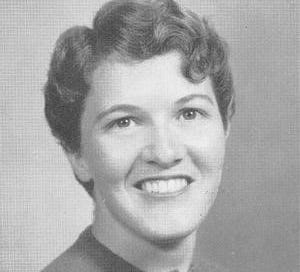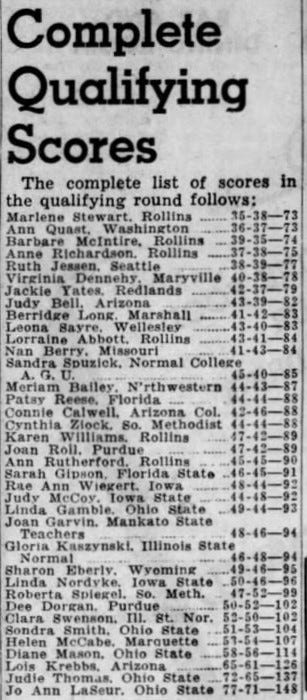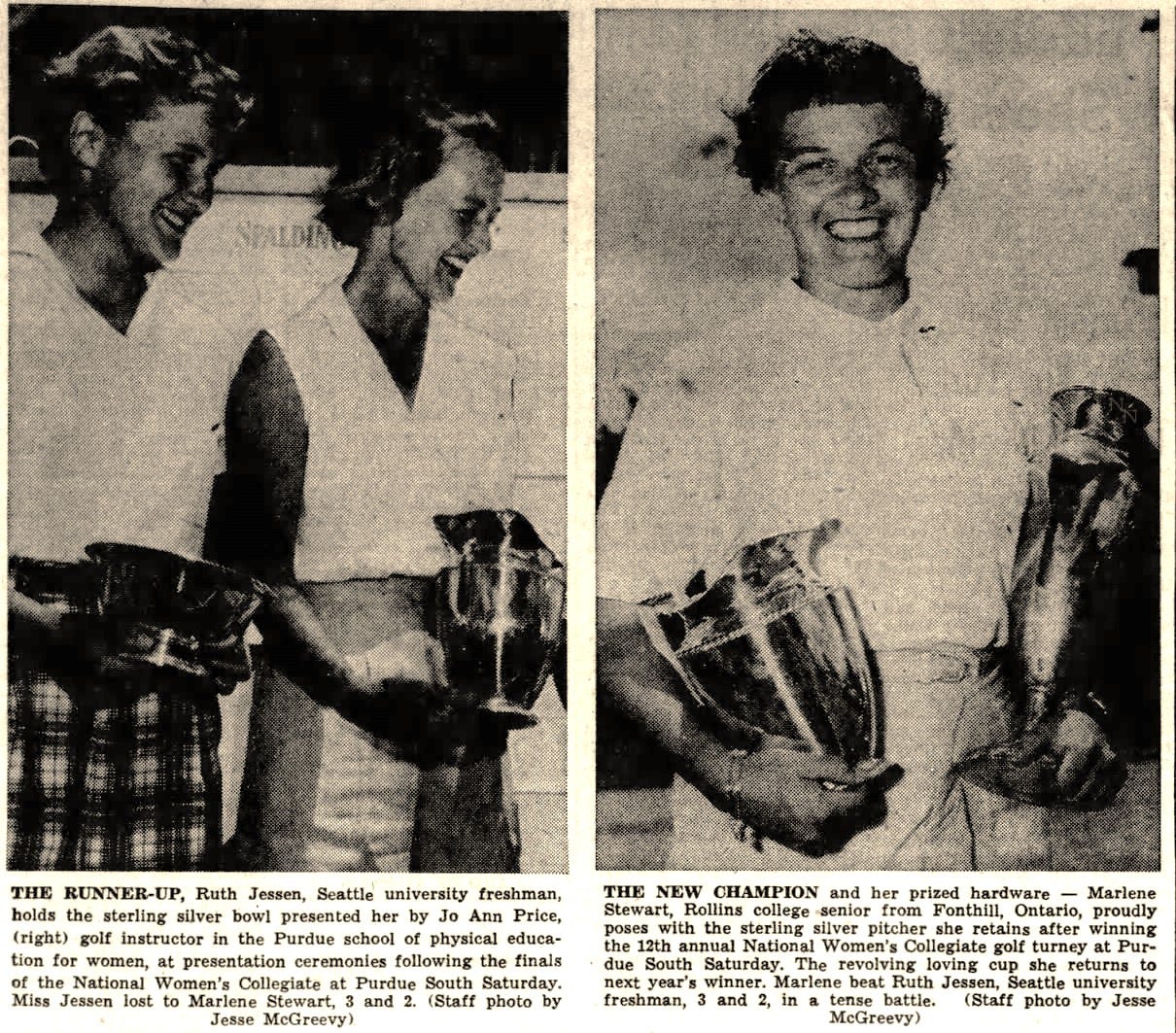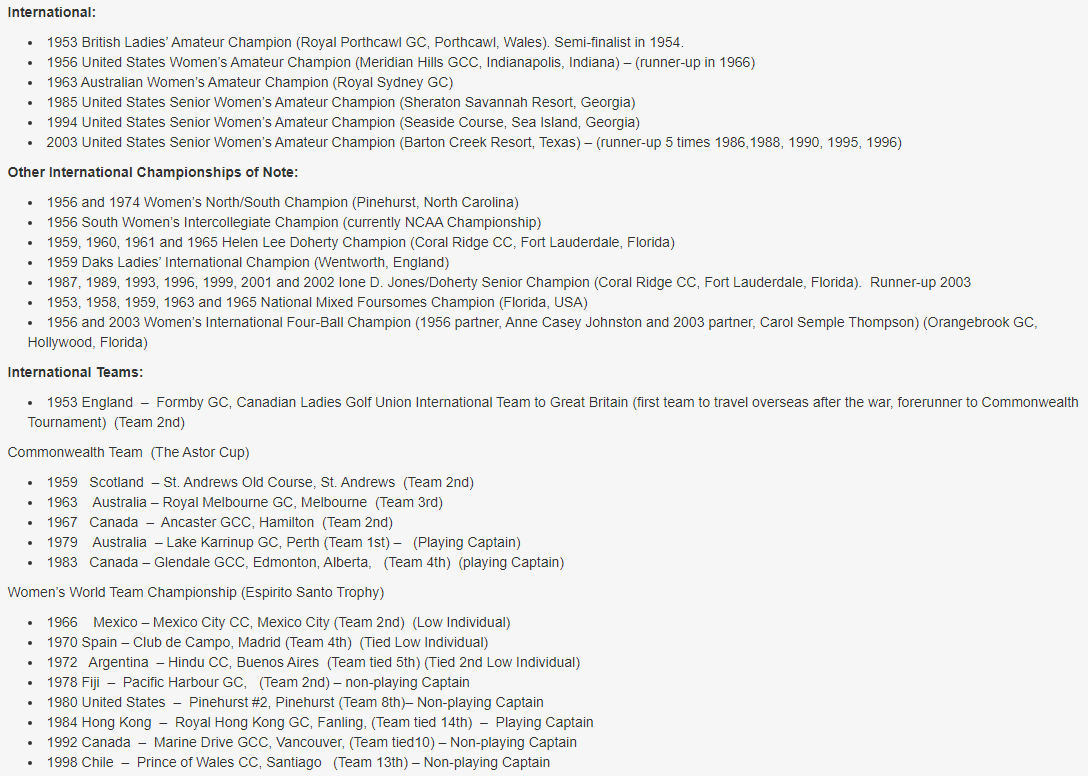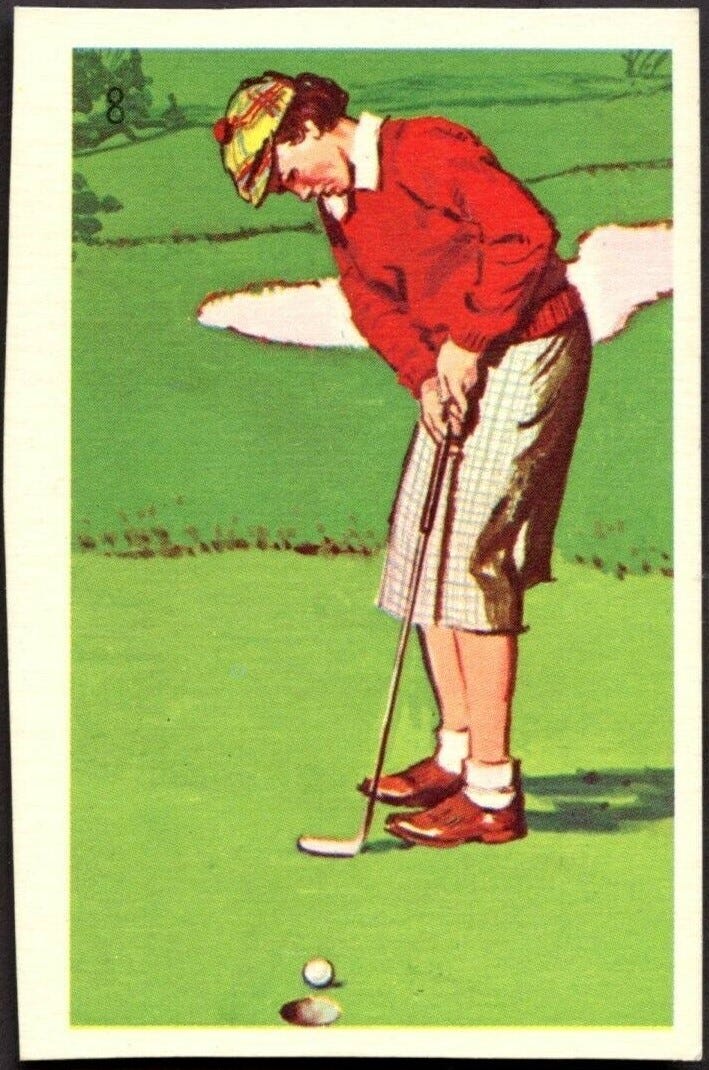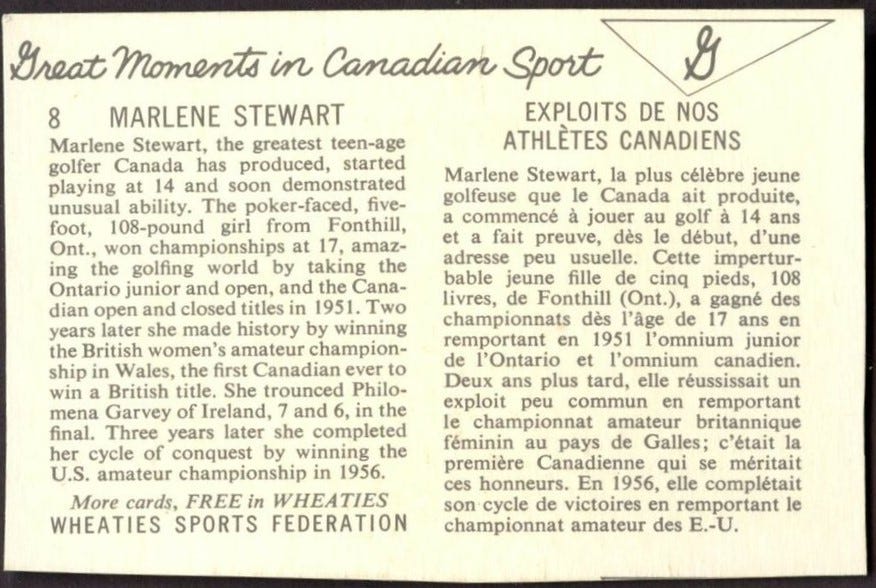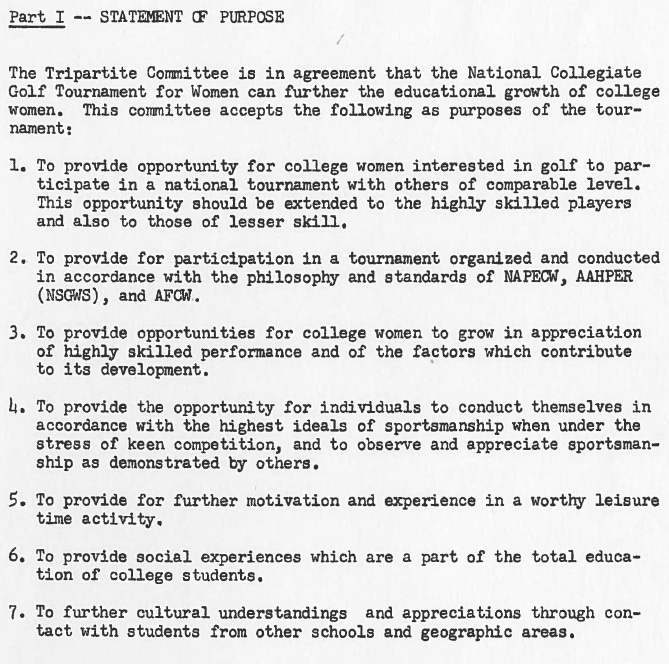This is part of a series on the Women’s Collegiate Championships
The 1956 Women’s National Collegiate Golf Tournament was a turning point for the championship in several interesting ways. At the organizational level, the development of an official body to manage the tournament created both stabilization and a vision for the future. The fact that this body, The Tripartite, was a coming-together of three national organizations also meant that there were broader implications for women’s athletics, not unlike what had occurred with the creation of the tournament in 1941.
On the player level, the emergence of Rollins College’s Marlene Stewart as an international amateur golf superstar helped shine light on the fact that the women’s game was trending younger. There are still the lingering references to “co-ed golfers” when reporting on women’s collegiate golf (well, women’s sports in general), but more than ever the headlines and body of the newspaper clips contained references to “Women’s [regional/state/national/international tournament] Champion” when discussing individual players’ accomplishments. The recognition that these were not junior thespians dreaming for the far-off chance at Broadway, but rather already proven Broadway actors playing on the collegiate stage was an important revelation for the golf community at large.
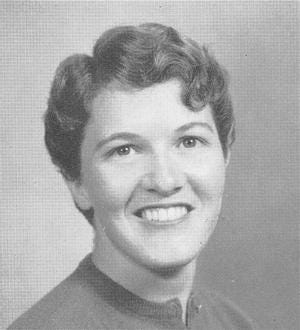
*NOTE 1: underlined text provides a link to references or sites with more information
*NOTE 2: we have done our best to cull out sources that contain problematic language or sentiments, but sometimes those things cannot be helped or are otherwise included to illustrate a point; we hope you understand this usage and recognize its educational purpose is not an endorsement
FORMING THE TRIPARTITE

The Leadup
As mentioned throughout this series, a defining characteristic of women’s athletics is the hyper-organization the both preceded and accompanied the development of the sports themselves. Rather than necessarily being a bad thing, each of these organizations contributed (in varying degrees) to the structured growth of athletics, with the major downside being the slowness of that growth. Three of these organizations concerned with competitive intramural women’s athletics were:
American Association of Health, Physical Education and Recreation (AAHPER)
Athletic Federation of College Women (AFCE)
National Association for Physical Education for College Women (NAPECW)
Representatives of these three groups were originally brought together into the discussion of the Women’s Collegiate Golf Tournament in November, 1955, at the National Conference on Intramural Sports for College Men and Women. Although nothing was solidified here, Dr. Laura Huelster, University of Illinois’s Chairman of the Department of Physical Education for Women, agreed to host the 1957 tournament and her counterpart at Purdue University, Helen Hazelton, agreed to host the 1956 event. These decisions secured the immediate future of the event, and a few months later at the March AAHPER Convention, the Tripartite Committee was born in anticipation of solidifying a long term golf championship. Fifteen years after the first championship broke new ground, golf once again stood on the forefront of change in national women’s collegiate athletics.
1956 Committee Members
According to the first report generated immediately following the 1956 championship, the first Tripartite Committee included:
Sara Staff Jernigan, Stetson University, NAPECW Chairman, Committee on Intramural and Extramural Sports and Dance, National Association for Physical Education of College Women
Dorothy Wirthwein, Ohio State University, NAPECW Director of Intramural Sports for Women in university which was hostess institution for the golf tournament for several years
Joan Huesner (student), University of Nebraska, AFCW President-elect of the Athletic Federation of College Women
Mary Jean Mulvaney, University of Nebraska, AFCW Executive Secretary, Athletic Federation of College Women
Ellen Griffin , Women's College, University of North Carolina, Ex-Officio Staff member of college which served as hostess institution of the golf tournament for two years
Nancy Porter, Woman's College, University of North Carolina, AAHPER (NSGWS) Chairman, NSGWS Golf Committee and formerly a participant in this tournament
June McCann, University of California at Los Angeles, AAHPER (NSGWS) Member of Legislative Board of the National Section for Girls and Women's Sports
Rachel E. Bryant, Liaison, MHPER Consultant in Physical Education and Girls and Women's Sports
THE TOURNAMENT [June 12-16, 1956]
Four years prior to the 12th Women’s Collegiate Golf Tournament (Championship), Purdue had hosted the men’s championship in 1952. By all accounts, the men’s championship had been a tough but exciting display of good golf as North Texas won their historic 4th team title in a row. Now, playing from those same “men’s” tees, the women’s championship was expected to be an equally challenging affair with local newspapers predicting a close race between some of the top collegiate golfers in the country participating. By the end of the individual championship match four days later, it’s clear from the newspaper reports that the women had met and even exceeded those lofty expectations with their exceptional play.
STROKE PLAY
INDIVIDUAL RESULTS
All of the expected contenders made match play, including the four semifinalists from the previous year. The only real surprise during qualifying was the low scoring. Marlene Stewart [Rollins] and Ann Quast [Washington] shared medalist honors with a two-over (men’s) par 73. Stewart’s teammates came in right on her heels with a 74 (Barbara McIntire) and 75 (Anne Richardson). Putting those scores in perspective, those 73s would have placed the women in the top 25 after the first round of the 1952 men’s championship, behind the likes of first round leader Ken Venturi [San Jose St] (69) and eventual medalist Paul Harney [Holy Cross] (70). If not for bogies on both back-nine par 5s, Stewart could have easily shot par or better for the day.
The final two slots for match play were decided by a 3-for-2 playoff between Connie Calwell [Arizona], Patsy Reese [Florida], and Cynthia Ziock [SMU]. Calwell claimed the first spot with a par on the first hole, while it took Reese two more holes to finally claim hers.
TEAM RESULTS
Newspaper accounts completely disregarded the team aspect, likely due to the fact that it had not been recognized the last few years, but also possibly because only Rollins and Ohio State had more than two representatives. Based on the scores as well as those records collected by Margo Anderson for her 1969 thesis The History of the Women’s National Collegiate Golf Tournament, it would seem that Rollins is considered the winner by either two-player or four-player team scores. If we were to just look at the best two-player scores for any given team (as had been done in past tournaments), then the placement would be something like:
Rollins (147)
SMU (187)
Iowa State (188)
Purdue (191)
Illinois State [Normal] (196)
Ohio State (197)
Arizona (208)
MATCH PLAY
While one co-medalist, Marlene Stewart, had a huge 9&7 win in the first round of match play, the other (Ann Quast) was upset after 19 holes. Another big upset was Seattle freshman Ruth Jessen defeating Northwestern’s Meriam Bailey. Several big names moved into the quarterfinals including Jackie Yates, Anne Richardson, Virginia Dennehy, Judy Bell, and Barbara McIntire.
Stewart continued her torrid pace, defeating Dennehy 6&4 in the quarterfinals. Her opponent was none other than Yates, the reigning champ. A second Rollins player, McIntire, gained her second straight semifinals appearance, missing her opportunity for revenge against Marshall’s Berridge Long (last year’s runner-up) who was upset by this year’s unlikely sensation, Ruth Jessen.
For the third straight round, Stewart’s opponent was forced to shake hands in defeat before even making it to the 15th tee. In the last three days, Marlene Stewart had only played 57 of the possible 72 holes and had done so at only 1 over par. After beating last year’s champ, Marlene hoped she would be meeting fellow Rollins star and last year’s medalist, Barbara McIntire. Instead, Ruth Jessen, following in the footsteps of Pat Lesser just two years before, defeated McIntire to set up a rematch of the North and South Women’s Amateur.
Just a few weeks prior to their collegiate finals match, Stewart and Jessen met in an early match at the prestigious Pinehurst amateur tournament where Jessen had three-putted the 17th hole to lose her advantage and eventually the match. A three-putt on the 3rd hole at Purdue put Jessen down early and she never recovered. She had survived a gauntlet of experienced college players and took her opponent to the 16th green - which neither had seen since Tuesday’s qualifier round - but ultimately Ruth Jessen fell short of the title. With her 3&2 victory, Marlene Stewart became the second Rollins player to be crowned intercollegiate champion (Betty Rowland (Probasco), 1950) and gain custody of the Ohio State Rotating Trophy for a year.
MARLENE (STEWART) STREIT
As written in her bio in the Canadian Golf Hall of Fame:
One of the most revered and recognized female golfers in Canada and around the world, Marlene Stewart Streit personifies the dedication and determination of Canadian golfers. Streit is the only player to have won the Canadian, U.S., British and Australian Amateur Championships. She is an inspiration to many of Canada’s top young female amateur golfers.
HALL OF FAME CAREER
Marlene had been an exceptionally good player while in college, but it wasn’t until her championship in her senior year that she really broke through. Her efforts on the course resulted in her eventual entry into the Rollins College Hall of Fame.
Outside of college golf, her list of accomplishments is incredible not only for the achievements themselves, but also the types of high-level international amateur tournaments she competed in and span of time her exceptional career lasted. As summarized by the Canadian Golf Hall of Fame:
NATIONAL ICON
Marlene’s importance as a Canadian sports star cannot be fully encapsulated in just a few sentences here, but the fact that she was one of the rare golfers to get multiple sports cards speaks volumes. She even appears in the Wheaties line of “Greatest Moments in Canadian Sports” line as seen below. Her exceptional play as well as the fund generated in her name to boost junior Canadian golfers in the decades following her playing career (still operating as of 2024) serve as an ongoing symbol of her importance to the international golf community.
The podcast FORE the Good of the Game has a wonderful series of interviews with her telling her incredible story, check them out here:
TRIPARTITE MOVING FORWARD
THE 1956 REPORT
The first report - dated June 15, 1956 and sent to the governing boards of the NAPECW, AAHPER (NSWGS), and AFCW - included seven pages consisting of a statement of purpose for the tournament, suggestions for the joint committee, and a recognition of a growing problem in women’s collegiate athletics that needed to be addressed. Of particular interest are Parts I and III:
SETTING THE MACHINE IN MOTION
It took some time for each of the three organizations to consider and deliberate on the substance of the Tripartite Committee report from 1956, but in the end each of them approved the recommendations, with minor edits, and came to the general consensus that the tournament should move forward as planned. At each of the next two tournaments - hosted by Illinois (1957) and Iowa State (1958) - more of the necessary processes and policies were developed which effectively solidified the golf championship moving forward.
In time with the third report in June, 1958, the three groups to the bold step to create the National Joint Committee on Extramural Sports for Collège Women (NJCESCW) whose largest purpose was to establish standards for local and national extramural sports. Although the Tripartite Committee responsible for the continuation of and reporting on the annual golf tournament was folded in under this joint organization, it remained at the forefront of the entire group’s endeavors. One of their first major acts was the creation of a handbook that would be updated each year with all of the historical records, rules, and necessary information to guide the next hostess school in developing another successful golf tournament. This became a crucial living document as the championship flourished in the 1960s.
Thanks for reading!
Up Next:
In the next post for this series, we will cover the great Arizona State Sun Devil dynasty which includes the 1960 championship won the “The Great Gundy.”

